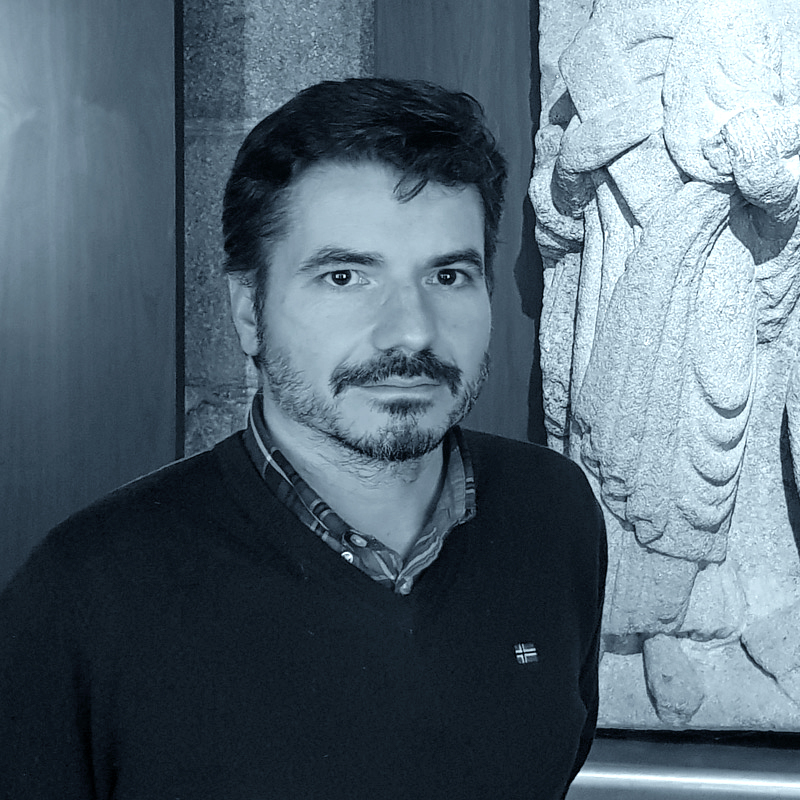

Art in the Compostela Era: a Cathedral for the Kings of Galicia
ART IN THE COMPOSTELA ERA: A CATHEDRAL FOR THE KINGS OF GALICIA
Ramon Yzquierdo Peiro. Santiago Cathedral Museum
SUMMARY
The role played by kings and queens was fundamental to the creation and consolidation of the Jacobean phenomenon and the cathedral of Compostela; also with regard to the artistic field, so that every great project developed in the basilica was possible, always, thanks to the determined support of the monarchy. Thus, as tradition has it, without the impetus given by Alfonso II to the miraculous discovery of the apostolic tomb, this event would not have reached the dimension it had immediately; and, later, thanks to Alfonso III, a new temple was set up to accommodate more and more pilgrims, at the same time, who began to arrive the first royal offerings which, in addition to privileges, meant rich objects that came to form the Compostela Treasury.
To the support of the kings of each moment, are due the different stages that marked the construction of the Romanesque cathedral, initiated by Alfonso VI, -who had taken away from his brother García the kingdom that his father had granted him in the partition made at his death-, which was represented in one of the so-called "foundational capitals" located at the head, and continued by his daughter Magpie at the hands of Archbishop Gelmírez who also educated the future Alfonso VII, crowned King of Galicia in 1111, still a child at the high altar of the temple. It was in this Gelmirian period that he set up a new cathedral conceived under the direction of the prelate himself and which had the participation of a select group of artists of French origin led by the so-called Master of Silverware. It was, without a doubt, the first half of the 12th century, a time of splendor in which most of the so-called Compostela era was concentrated.
After Gelmírez, two other kings of Galicia were key to finishing the construction of a cathedral that was still unfinished, this time with the participation of Mestre Mateo, who took over the direction of the works in 1168, thanks to a Privilege granted by Fernando II; and ended in 1211, when the solemn consecration ceremony took place in the presence of Archbishop Pedro Muñiz and King Alfonso VIII.
The Mateano project, fundamental for the creation of a new style and a Galician art with its own personality that began in the cathedral of Compostela, was also an update of what was already done in previous stages, among other things, because the temple was to become, along with its character of apostolic sanctuary and episcopal see, in the national cathedral and burial place of the kings of Galicia and their family. To this end, a new Royal Pantheon was officially set up, at the northern end of the transept, where his most immediate ancestors had most likely been buried before.
Today, despite having an exceptional historical relevance and being, curiously, little known among Galician society, the cathedral still houses the Royal Pantheon of Compostela, although, as such, it was moved in 1535 to its current location in the building. cloister. There are, among others, the frying pans with the lying sculptures -of Matean influence- and the remains of kings Ferdinand II and Alfonso VIII, Queen Berenguela and Raymond of Burgundy, husband of Queen Urraca.
Therefore, the journey through art in the Compostela Era will be an artistic journey to the construction of the first basilicas associated with the apostolic tomb, the construction process of the Romanesque cathedral, divided into successive phases until its conclusion with the consecration ceremony and the configuration of the Royal Pantheon. Finally, to those witnesses and artistic objects that have come down to our day, either in their original locations, or incorporated, in various ways, into the holdings of the Cathedral Museum of Santiago.
Ramón Yzquierdo Peiró
(Santiago de Compostela, 1972)
In 2009 he was appointed Technical Director of the Cathedral Museum of Santiago, which he currently holds. Previously, since 2044, he was Conservator of this same institution, today managed by the Santiago Cathedral Foundation; with which he had been collaborating closely for some time before.
He holds a PhD in Art History from the University of Santiago de Compostela, with a thesis focused on the study of the artistic collections of the Cathedral of Santiago, directed by Professor José Manuel García Iglesias, which obtained the highest grade by the court. He also holds a degree in Geography and History, specializing in Art History, from the same University; Master in Management and Conservation of Cultural Assets from the University of A Coruña; University expert in Environmental Interpretation and Cultural Heritage from the Open Universities of Catalonia and the Balearic Islands; and Specialist in the conservation of Cultural Heritage by the Spanish Historical Heritage Institute (Ministry of Culture).
He completed his training in museology, management and conservation of cultural heritage with scholarships for specialization and research from the Ministry of Culture, the Xunta de Galicia and the Provincial Council of A Coruña.
He develops much of his work in the field of museum project development and temporary exhibitions. In this section, among other outstanding samples, he was Curator and director of editing the catalog of Mestre Mateo, held between 2016 and 2018 at the Museo Nacional del Prado and the Museo Catedral de Santiago.
His research activity focuses mainly on the study of the cathedral's artistic collections, in particular the Mateano project and the collection of tapestries, being the author of numerous publications, scientific and informative articles, book chapters and monographs.


